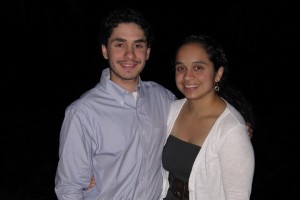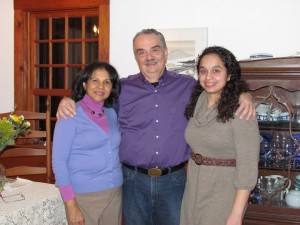Meeting John
When I moved to the US, I didn’t really think about developing romantic relationships. I think that there were ways in which the attractions in the US were almost like a surprise to me because it was not on my mind. Initially the community I was in on 81st Street was a primarily Jewish community in the 60s, and as a teenager, I was meeting kids in school, but I wasn’t really searching for that. I wasn’t searching for a match. I don’t think I was ever really searching for a match.
It was a wild time in this country because of the cultural changes that were going on and the war and the rebellion that was happening in my age group. I wasn’t really a part of that. I was a witness to it, but a willing witness because many times I found myself in situations that I didn’t quite understand— I didn’t really understand all the background history to what was happening, and I was truly a foreigner in a foreign land. And I had peers in my age group and participated in a lot of things with them, but not because I understood all of what was going on. So it was the same in having boyfriends or meeting people—it was all very foreign to me, especially the way men and women related here. I came from a very traditional background; although the nuns inculcated early on that education was very important, the role of women in my country was very traditional—it was to marry, establish your home, have children and be a support to your husband. So coming to this culture, I saw a different model.
I didn’t really understand all the background history to what was happening, and I was truly a foreigner in a foreign land. And I had peers in my age group and participated in a lot of things with them, but not because I understood all of what was going on. So it was the same in having boyfriends or meeting people—it was all very foreign to me, especially the way men and women related here. I came from a very traditional background; although the nuns inculcated early on that education was very important, the role of women in my country was very traditional—it was to marry, establish your home, have children and be a support to your husband. So coming to this culture, I saw a different model.
So I meet John, who is now my husband, one year before I had already considered moving to the Dominican Republic. We had a wonderful time in that year, and we realized had similar interests, and in some ways, interestingly, somewhat similar backgrounds in terms of our religious practices and being a part of youth groups. By the end of 1972, I had made the decision I was getting a job in the DR. I returned in 1972 and informed John that I was getting a job and moving into the Dominican Republic. By that point, I had already been in nursing for two years, and already had an associate’s degree. I felt that at that time I certainly had the credentials and basic skills to work in my country. So I did go down in 1973. But I returned after one year, and John and I married in a church.
Family
After John and I got married, we moved to Norwich, VT, where I had two children: Jonathan, who is 28, and Elysa, who is 26. They are both very independent human beings; right now, they are in their mid-twenties, carving their ways and finding themselves in the world and their relationships to the world. Both grew up with professional parents, so there were high stresses. We we were careful not to impose any of our own expectations of what they could be, but certainly communicated messages about their capabilities and encouraged them to reach high because they were both very capable. That was important in their own success—not necessarily financial success, but feeling successful as human beings in what they could do.
Coming to the US, I have seen different models of raising children. I came from a culture where my mother told me: “If you want to go to college, you better get to work.” So by age 16, I’m working part-time while I’m still in high school and continue all the way through to get myself to college. But with my children, I didn’t create limitations and I didn’t set rigid expectations—I didn’t force them to become a doctor or a nurse because their parents were—it’s where your interests lie and where you are the most capable, and go for that.
Jonathan graduated from St. Lawrence University after spending a gap year at a private school in northern Maine. He went to Hanover High School, just like my daughter did. They were both born at the Old Hospital where Geisel Medical School is located right now. My son is very athletic. Of course, growing up in this community, they were both very athletic. Jonathan did both mountain biking and skiing; as independent as he is, he does not like to go through the trails that are already there. So in the winter he creates trails and he does that for biking as well. Right now, he’s working more freelance in Stowe, VT, doing work in designing for the computer.
Elysa attended Dartmouth College and played hockey and was in crew. She was an ice hockey goalie in high school and goalie for a men’s club. Right now she lives in Boston and works at a charter school in education. She got turned on to education during her time at Dartmouth. She loves working with children from under-resourced communities, who, in many ways, are also academically at-risk. She is very competent and very successful in what she does right now. She certainly has other things to do and other things to accomplish, but it is on her own time—it is not on my time or on my expectation.
My Children’s Dominican Identities
With my daughter, I don’t think I imposed too much of the Dominican culture on her, but I did commit myself to take them to my country shortly after they were mobile. Elysa has visited my country since age 18 months, and from there on, both of them have visited fairly regularly. At that time, in the 80s, I just wanted them to see a different face of life—to witness poverty first-hand, not necessarily live it, and to witness struggling communities.
In raising her, I’ve synthesized the two cultures and found aspects of each, and used that as a parent. I adapted some ways in which I was raised: there are ways in my country that you are expected to sit, expected to speak, expected to behave—I know some of those things because I feel they are valuable anywhere you are. But I also taught her to be herself. Elysa was raised her with her brother. As toddlers, he would dress as a cowboy and she would dress as a cowgirl. And so it meant that whatever he was doing, she also did. But she did it as a little girl, and he did it as a little boy. So in that sense I don’t feel that I reinforced the difficult distinction that my country creates between boy and girls, like making her be a domestic, for example.
I don’t think either one of them embrace the Dominican culture, or would identify themselves as Dominican. This is an interesting community where they were born and raised. I know my daughter embraces her mother’s migrant experience very fully and of being of mixed race. In any situation where the topic of conversation may be the Latino experience or the Dominican experience, she will have things to say and will become part of that experience. She’s met Juno Diaz and will find ways to become a part of that conversation. Elysa speaks 4 languages. She learned French and Italian here, and Spanish of course. I don’t take a lot of credit for that; I think it was her abilities; her abilities were very strong in the languages.
My sense with Jonathan, however, is that there was a rebellion and rejection on his part of being a mixed race, and I think it is in part because guys wanted to fit in. If you didn’t raise the question, nobody would know he was of Latino culture because of his looks—he looks very much like his dad. His dad was born in Nashua and raised in New York, of New England families, so, Jonathan doesn’t have that appearance, but at least Elysa has very much of a Latino profile and presentation in her looks.


